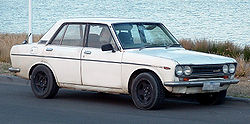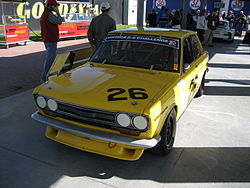- Datsun 510
-
Datsun 510 

Manufacturer Nissan Also called Datsun 1600, 1500, 1300
Datsun Bluebird
Yue Loong Bluebird 706 (Yulon, TW)Production 1968-1973 Assembly Oppama, Japan Body style 4-door sedan
2-door sedan
2-door coupe
5-door station wagonLayout FR layout Engine 1.3L L13 I4
1.3L J13 I4
1.4L L14 I4
1.5L J15 I4
1.6L L16 I4
1.8L L18 I4Wheelbase 95.3 in (2,421 mm) Length 163.2 in (4,145 mm)(estate) Width 61.4 in (1,560 mm) Height 55.14 in (1,401 mm)(estate) Curb weight 2,184 lb (991 kg) (Estate - approx) Related Nissan Skyline GT-R
Nissan SkylineMain article: Nissan BluebirdThe Datsun 510 was a series of the Datsun Bluebird sold from 1968 to 1974, and offered outside the U.S. and Canada as the Datsun 1600. According to AutoWeek's G.D. Levy, the 510 has often been called the "poor man's BMW." The 510's engineering was inspired by contemporary European sedans, particularly the 1966 BMW 1600-2, incorporating a SOHC engine, MacPherson strut suspension in front and independent, semi-trailing arms in the back.[1] The European-influenced sheet metal design is attributed to Datsun in-house designer, Teruo Uchino.
The engine was pushed through by Nissan USA president Yutaka Katayama, a design developed through Prince, an acquisition, with some Mercedes Benz influence.[2]
Launched in August 1968, it was one of the most comprehensive Bluebird ranges in terms of body styles: a two-door sedan, a four-door sedan, a five-door station wagon, and a two-door coupé (added in November 1968).
This range became famous for Nissan's rallying successes outside Japan and paved the way for greater Nissan sales internationally.
The Datsun 510 released to the U.S. market came originally with the Hitachi downdraft carbureted 1.6L L-series I4 engine, with an advertised gross power of 96 hp (72 kW), a claimed top speed of 100 mph, front disc brakes, 4-wheel independent suspension (MacPherson strut front and semi trailing arm rear- wagons had a solid rear live axle and leaf springs in back), rear wheel drive, and either a 4-speed manual or a 3-speed automatic transmission. 2-door sedan, 4-door sedan, and 4-door station wagon variants were available. It achieved 20-30 mpg in factory trim (U.S.). JDM spec models were also available in a 2-door coupe body style in either a 1.6L or a 1.8L (1973) L-Series engine. 510's in some markets offered available twin Hitachi side-draft carburetors, which were a smaller version of the British SU (Skinner's Union ) design used on Jaguars and MGs[citation needed]. These engines also used enhanced compression and camshaft profiles to produce more power. SSS models (not available for the U.S. 510) offered upgraded instrumentation and interior trim, as well as appropriate exterior badges. All U.S. model 510s received anti-sun glass from 1970-on.
Contents
Popularity
Affordable performance combined with simple and reliable mechanicals has helped the Datsun 510 remain a popular automotive enthusiast's car for nearly 40 years. Avid collectors can be found around the world with significant numbers in the US, Australia, & New Zealand.
One advantage of the early Nissan/Datsun cars is that many of the parts are interchangeable — engines, transmissions, suspension setups, etc., were all similar enough to swap with minor modifications. This allowed the Datsun 510 to be easily upgraded from the 1.6l - L16 engine, to the 1.8l - L18 engine, and later to the 2.0L L20B engine, and to go from the 4-speed manual transmission to the 63mm (shaft-center distance) 5-speed transmissions made available for the early (S10) 200SX and (A10) HL510, and the 71mm 5-speed transmissions used in the (S30 & S130) 280-series Z cars, '80-'83 (S110) 200SX, the '77-'80 (810) 810, the '81-'84 (910) 810/Maxima/Bluebird, and the C210/R30 series of Skylines. The 71mm 5-speed transmissions also saw extensive use in the 620/720/D21 series pick-up trucks in both long and short (rare) extension-housing versions.
Its positive reputation also led to Nissan re-uing the 510 model name later on for the unrelated, and mediocre, 1978-1981 Nissan Stanza 'A10' in an effort to capture this range’s glory, an effort reviewers thought a failure.[3]
Variations and market differences
The PL510 was the most prevalent model in most markets, including the U.S. The 1969 KP510 two door coupe twin SU version arrived in small numbers to right-hand-drive markets, predominantly, Japan's domestic market, unsaddled by engine emission regulations. 'K' series 510s had a coupe-style swept roofline and shorter deck lid. In the U.S., the 1968 510 2-door sedan saw a limited introduction in April, resulting in it being the rarest U.S. 510 year/model. The 2-door sedan body style became popular and was imported into the U.S. in large numbers for the next 5 model years. For the 1973 U.S. model year, the 510 4-door sedan was dropped in favor of the 1973 P610 series cars. Around the world, the J series push rod engined model was most common.
In September 1970, the 1.3 and 1.6 L engines were replaced with 1.4 and 1.8 L units. In other parts of the world the 510 was equipped with J series OHV push rod engines.[citation needed] In the US it remained a 1.6.
Australian versions of the Datsun 1600 were delivered either as a full import (1967 & early 1969), or assembled in Australia from local and Japanese parts. These 510 Datsuns were equipped with L16 engines. Australia officially only received the 4-door Sedan & Station Wagon models.[citation needed]
South American versions of the Datsun 510 were delivered with OHV push rod engines J series variety and leaf spring suspensions (no IRS) on all models.
The 510 was sold in Taiwan as the Yue Loong Bluebird 706 and was powered by the J13 from the 411 and leaf spring rear suspension.
The Datsun 510 differed with the markets it reached. In South America, Asia (excluding Japan) and in Africa, 510 sedan, 2-door & station wagon models traded rear independent suspension for a leaf-sprung solid axle. The engines for these markets also differed. Rather than the OHC 1.6l L-series, they received push-rod inline 4 cylinder engines from the J-series with either 1.3l or 1.5l displacement. These variants were also known as Datsun 1500 (J15 engine) and Datsun 1300 (J13 engine). In these markets, the IRS Datsun with the L series engine was the Datsun Violet, aka 160JSSS. In the US, the Datsun 710 was the non IRS version of the Datsun 160JSSS. It appears the Datsun 510 was favored by Nissan in North America, while the Datsun 160JSSS was the choice outside of North America. The Datsun 1600 P510 was built in South Africa in Pretoria between 1969 and 1974. They were available as a 1600 deluxe, 1600 SSS sedan, 1600GL, 1600GL SSS and 1800GL SSS. They all had independent rear suspension and the SSS versions had twin carbs. These cars were very popular for motor sport in South Africa.
The last of the P510 series went through Australian assembly lines in 1972, and due to the extensive use for rallying, the cars are now quite hard to find in any reasonable condition. In the U.S., Datsun P510 cars are becoming increasingly rare in the Rust Belt regions, but can still be seen in the more temperate Western and Southern States. Greatest numbers of the cars seem to be in the West Coast region.
See also
References
- ^ George Damon Levy. "Pete Brock's "Screaming Yellow Zonker."" AutoWeek. 20 January 1986. Retrieved 6 October 2007 from The Dime, Quarterly.
- ^ "The Bluebird Takes Wing...". Archived from the original on 28 September 2007. http://web.archive.org/web/20070928051126/http://www.the510realm.com/510history/car/index.html. Retrieved 2007-10-06.
- ^ Michael Lamm (January 1978), "Driving the Datsun 510", Popular Mechanics: p. 87, http://books.google.co.nz/books?id=fM8DAAAAMBAJ&pg=PA87
External links
Nissan Motor Company Vehicles Current370Z • Advan • Altima • Aprio • Armada • Atlas • Bluebird • Bluebird Sylphy • Cabstar • Caravan • Civilian • Clipper • Cube • Dualis • Elgrand • Frontier • Freeson • Fuga • GT-R • Juke • Lafesta • Leaf • Livina Geniss • Maxima • March • Murano • Moco • Navara • Note • NV200 • NV400 • Otti • Paladin • Pathfinder • Patrol • Qashqai • Quest • Rogue • Safari • Sentra • Serena • Skyline • Teana • Tiida • Titan • Urvan • Versa • Wingroad • X-Trail • XterraPastDC-3 • 100NX • 1200 • 310 • 180SX • 200SX • B-210 • 240SX • 240Z • 280ZX • 300C • 300ZX • 350Z • 510 • 810 • Almera • Almera Tino • Altra (EV) • Avenir • Auster • Bassara • Be-1 • Caball • Cablight • Cedric • Cefiro • Cherry • Cima • Crew • Datsun Truck • Echo • Expert • Fairlady • Figaro • Gazelle • Gloria • Hardbody Truck • Hypermini • Homy • Interstar • Junior • Largo • Laurel • Leopard • Liberty • Mistral • Multi • NX • Pao • Pintara • Pino • Platina • Prairie • Presage • Presea • Primera • President • Pulsar • Pulsar GTI-R • R390 GT1 • R'nessa • Rasheen • Roadster-Road Star • S-Cargo • Saurus • Saurus Jr • Silvia • Sileighty • Skyline GT-R • Stanza • Stagea • Sunny • Terrano • Terrano II • Vanette • VioletConcept126X • 216X • 270X • 300 Bambu • 315-a • AA-X • Actic • AD-1 • AD-2 • AL-X • Alpha T • Amenio • AQ-X • AP-X • ARC-X • AXY • AZEAL • Bevel • Boga • C-Note • Chapeau • Chappo • Cocoon • CQ-X • Crossbow • CUE-X • Cypact • Duad • Dunehawk • Effis • ESV • Evalia • EV Guide II • EV Truck • FEV • FEV-II • Foria • Forum • Fusion • Gobi • GR-1 • GR-2 • GT-R • ideo • Intima • Jikoo • Judo • Jura • Kino • KYXX • Land Glider • LEAF • LUC-2 • MID4 • Mixim • mm.e • Moco • Nails • NCS • NEO-X • NRV-II • NX-21 • NV2500 • Pivo • Pivo 2 • Qazana • Redigo • Round Box • Serenity • Sport Concept • Stylish VI • Terranaut • Tone • Townpod • Trailrunner • TRI-X • URGE • UV-X • XIX • XVL • Yanya • ZarootEngines GRX-3 • UD12 • VRT35Marques Nissan • InfinitiSubsidiaries
and divisionsSee also ATTESA • Datsun • HICAS • Prince • Renault-Nissan Alliance • Nissan Shatai • UD Nissan Diesel • VVL • VVEL • dCi
Categories:- Datsun vehicles
- Rear wheel drive vehicles
- Rally cars
- 1960s automobiles
- 1970s automobiles
- Vehicles introduced in 1968
Wikimedia Foundation. 2010.

